The workshops are to be held at the Informatics Forum at the Department of Informatics, in George Square (Central Edinburgh, 10 Crichton St, Edinburgh, EH8 9AB) on the 19th of Jly 2016. HOW TO GET THERE
To attend the workshops will attract a small fee intended to cover the costs of the meeting. For fees and online registration go to REGISTRATION
download WORKSHOPS PROGRAMME workshop_info_pack.pdf
_________________________________________________________________________
Our Future with Living Machines: Societal, Economic, and Ecological Impacts
Organisers:
Prof. Jose Halloy, Université Paris Diderot (UPD), France
jose [dot] halloy [at] univ-paris-diderot [dot] fr, http://www.lied-pieri.univ-paris-diderot.fr/spip.php?article93
Prof. Tony Prescott, University of Sheffield, UK,
t [dot] j [dot] prescott [at] sheffield [dot] ac [dot] uk, https://www.sheffield.ac.uk/psychology/staff/academic/tony-prescott
 Abstract: This one-day workshop will consider our future lives with Living Machines exploring themes of broad public interest including:
Abstract: This one-day workshop will consider our future lives with Living Machines exploring themes of broad public interest including:
● the societal impacts of biomimetic and biohybrid technologies on human behaviour, personal freedom, well-being, human-machine relationships and on how we see ourselves;
● the economic consequences of advances in AI and robotics for human autonomy, including the availability of meaningful work, and the distribution of wealth in a globalised economy increasingly dominated by machine labour;
● the sustainability of a world where the construction of advanced ICT and robotic technologies will absorb critical resources, generate pollution, and create toxic waste.
In each of these areas we can ask what technology development can learn from living systems, and their ecosystems and societies, in the way they adapt to environmental change, exploit symbiosis, and build themselves from readily-available materials using green energy. We will explore the possibility of a “living machine” circular framework for societal, economic and ecological sustainability modelled on the self-regulating.
full programme here our_future_with_living_machines.pdf
Living machines that grow, evolve, self-heal, and develop: how robots adapt their morphology to the environment
Organisers: Dr. Barbara Mazzolai, Istituto Italiano di Tecnologia, Center for Micro-BioRobotics, Italybarbara [dot] mazzolai [at] iit [dot] it, www.iit.it
Prof. Cecilia Laschi, The BioRobotics Institute, Scuola Superiore Sant’Anna, Pisa, Italy cecilia [dot] laschi [at] sssup [dot] it

Abstract: A rich literature exist in bioinspired robotics and recently the use of soft materials and variable stiffness technologies in robotics represents an emerging way to build new classes of robotic systems that are expected to interact more safely with the natural, unstructured, environment and with humans, and that better deal with un-certain and dynamic tasks (i.e. grasping and manipulation of unknown objects, locomotion on rough terrains, physical contacts with human bodies, etc.).
This compliant bodyware also serves the purpose of implementing morphological computation principles, intended to better exploit the role of body in control of movements and to ultimately simplify the control of complex machines. Despite the big achievements in this field, robotics technologies are still inadequate to mimic the biological system capabilities in changing their morphology and adapting their body and functionality in their lifetime, by to growing, or even to by repairing damaged body parts. Evolution is somehow simulated with genetic algorithms and evolutionary robotics has reached important results, encouraging for applying this approach to design and build new robots. Instead, morphological changes within the same individual are still unmatched, except for few exceptions.This workshop intends to gather the few experiences in robots that grow, self-healing materials, evolutionary algorithms for robotics, and robot development and to provide a framework for discussion of the potential of such concepts, the challenges ahead and the approaches possible. Students and young researchers active in these fields are particularly encourage to participate in this Workshop by an open call.
full programme here living_machines_that_grow.pdf
The Emergence of Biological Architecture
 Abstract: Biological Architecture is a new interdisciplinary field centered around the ideas of designing and building new or improved innovative systems, objects or products based on the observed properties of biological systems. There is now an emerging community of researchers inBiological Architecture, which are growing across traditional academic disciplines in Edinburgh and beyond.
Abstract: Biological Architecture is a new interdisciplinary field centered around the ideas of designing and building new or improved innovative systems, objects or products based on the observed properties of biological systems. There is now an emerging community of researchers inBiological Architecture, which are growing across traditional academic disciplines in Edinburgh and beyond.
